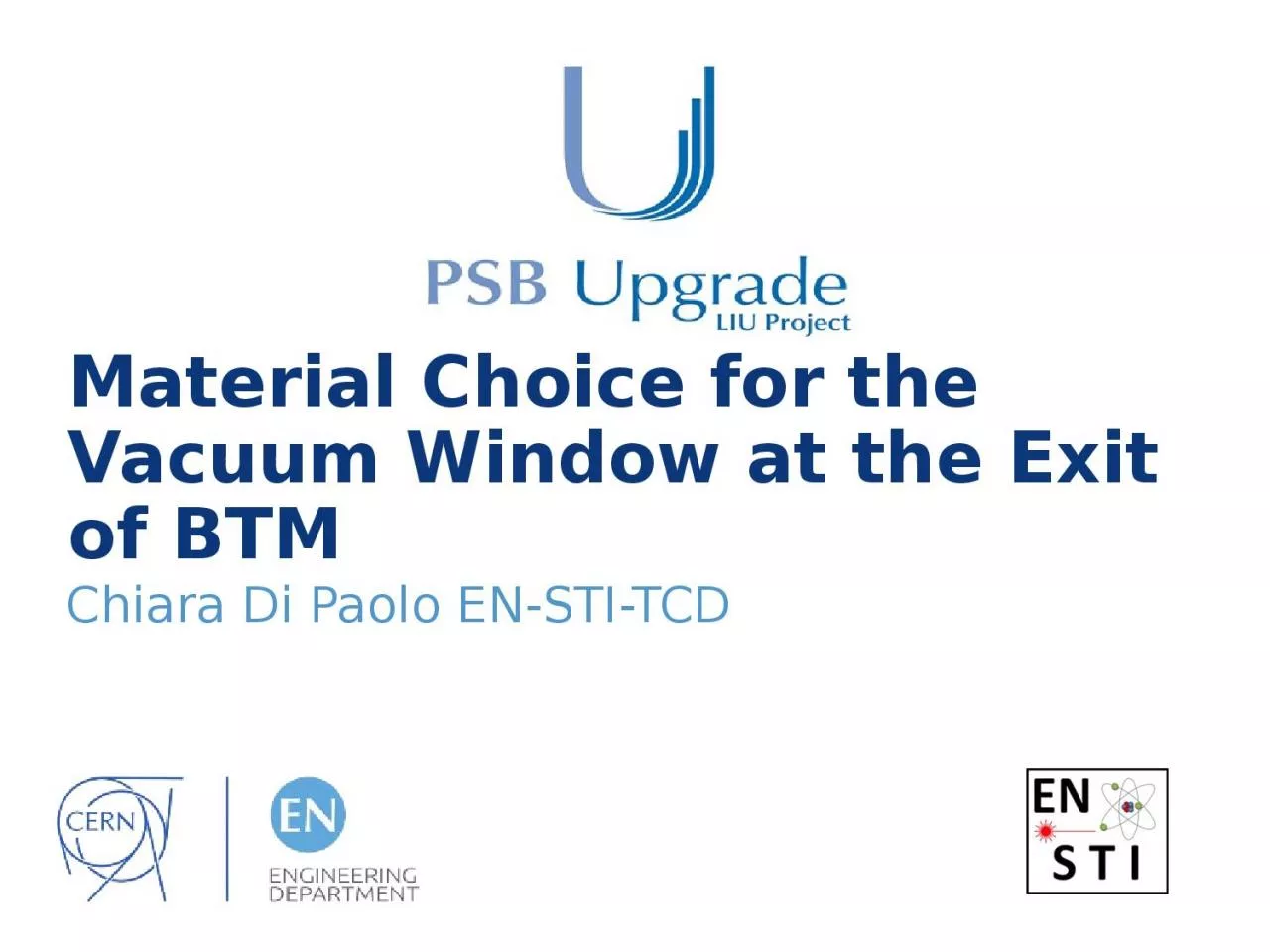

Material Choice for the Vacuum Window at the Exit of BTM CURRENT WINDOW Thin circular sheet of Stainless Steel 316L of 005 mm thickness and 200 mm diameter Located in the BTM extraction ID: 932737
Download Presentation The PPT/PDF document "Chiara Di Paolo EN-STI-TCD" is the property of its rightful owner. Permission is granted to download and print the materials on this web site for personal, non-commercial use only, and to display it on your personal computer provided you do not modify the materials and that you retain all copyright notices contained in the materials. By downloading content from our website, you accept the terms of this agreement.
Slide1
Chiara Di Paolo EN-STI-TCD
Material Choice for the Vacuum Window at the Exit of BTM
Slide2CURRENT WINDOW
Thin
circular sheet of Stainless Steel 316L of 0.05 mm thickness and
200
mm
diameter
Located
in the BTM
extraction line, at the end of the vacuum chamber upstream of the cavity of the dump
Drawing
from:
07.PSB.IHENS.0031.0, 07.PSB.IHENS.0363.3
Slide3PROPOSED
WINDOWSVery good mechanical properties and a lower density (that means lower energy deposition) respect to stainless steel 316L
Mechanical resistance
better
then other
material with lower density
(e.g. Beryllium, Aluminum or Glassy Carbon)Good resistance at high temperature and not problem of compromising the vacuum.
Considering the higher intensity of the beam and great stresses caused by atmospheric pressure, Ti6Al4V
has been selected as a material for the window. This Titanium alloy has:In the study two different configuration for the new window have been considered, both composed by a circular sheet of Ti6Al4V :0.05 mm thickness 200 mm diameter
0.1 mm thickness
200
mm
diameter
Slide4MATERIALS PROPERTIES
Properties (at RT)
Units
Ti6Al4V
Stainless steel 316L
Density
g/cm³
4,43
7,9
Yield Strength
MPa
995
300
Young Modulus E
GPa
113,8193Thermal ConductivityW/m·°C713Melting Point°C1604-16601371-1399Specific HeatJ/kg·°C513487
In the model all the material properties were considered temperature dependent.
Slide5Beam Parameters for Design
The analyses were performed for two
most critical types of
beams.
The maximum number of particles per pulse takes into account a margin of 30%.
Parameters
NORMGPS
LHC25ns
Max beam Intensity
1E14 particles per pulse
2,1E13 particles per pulse
Beam energy
2 GeV
2 GeV
Pulse Period2.4s (1.2s per cycle but dumped one out of two cycles)3s (0.9 s per cycle plus 1.2 cool-down cycles) Pulse length940 ns 2715nsNumber of bunches4 (2.5E13 p per bunch)4 bunches plus 2 bunches 900ms later (3.5E12 p per each bunches)Bunch spacing260ns (160ns full bunch 100ns between bunches)507ns (180ns full bunch 327ns between bunches)Main source: W.Bartmann, B. Mikulec, ,“PS BOOSTER DUMP UPGRADE”, EDMS PBU-T-ES-0002
Slide6FE ANALYSES
The stresses are generated mostly by the atmospheric
pressure.
The
rise of the temperature is due to the interaction between the proton beam and the
window
.For the estimation of
temperatures and stresses in operation, a separated physics simulation has been performed
(conservative approach).
Slide7Average
temperatures reached at
steady state
Temperatures
profiles at the
peak after one pulse
THERMAL
ANALYSES
Material
Thickness [mm]
Maximum Steady State Temperature [°C]
∆T [°C]
Maximum Temperature [°C]
Ti 6Al 4V
0,1
13121152Ti 6Al 4V0,0510220122Stainless Steel 316L0,0512123144The worst case for every possibility is with the NORMGPS beam
Slide8MECHANICAL
ANALYSES
The
static stresses generated by the atmospheric pressure are
tensile. They
are high in
the centre and in the perimetral region.
Window
Equivalent stress at the centre [MPa]
Equivalent stress
at
the perimeter [MPa]
Maximum displacement [mm]
Ti
6Al 4V 0.1mm4483686,8Ti 6Al 4V 0.05mm7425158,3316L 0.05mm39730210,7Stresses without the beam. The thermal expansion due to the beam load generates compressive stresses at the centre and consequently tends to decrease the stresses in the area.Anyway, there is a strong correlation between the temperature and the material strength, which drops with the increase of it. Therefore the centre remains a critical part being the region with highest temperature.The maximum displacement is located in the centre.Equivalent StressTotal deformation
Simulations by
Quentin
Deliege (TE/VSC)
Slide9PROFILE
OF TEMPERATURES AND STRESSESFor the Titanium windows
stresses are lower than the Yield Stress, so the material works in the linear elastic region without plastic deformation.
The atmospheric pressure
gives
the fundamental stress contribution, which does not change considerably with the new beam parameters,
while the temperature increases significantly with a remarkable reduction of strength.Temperature, equivalent stress and strength of the window are plotted along a radial path between the
centre and the flange for the three configurations of the window in the worst case.
Steady state Temperature
Steady state Temperature
Peak Temperature
Peak Temperature
Yield Strength
Yield Strength
Stress (Von Mises)
Stress (Von Mises)
Slide10PROFILE
OF TEMPERATURES AND STRESSESThe equivalent stress is higher than the yield stress and lower than the tensile strength: the material does not
remain in the linear elastic region and experiences plastic deformation.
Due to dynamic nature of the thermal load, the real stress can be higher,
provoking material failure and breaking
the vacuum tightness.
Steady state Temperature
Yield Strength
Stress (Von Mises)
Tensile Strength
Peak Temperature
Slide11CONCLUSION
The current window has a high risk of failure caused by the combination of high stresses and elevated temperature due to the exposition to the beam. It will be much safer to use a new window with a different material and higher thickness.
The final proposal is a window made of
Ti
6Al
4V
, with 0.1 mm thickness:higher thickness is much safer, reduces the stresses and it is advantageous in terms of workability and availability from the supplier.
Lower density is better in terms of radiological activation,
this simplifies interventions in the area by reducing the dose rate.
Slide12ASSEMBLY
The window design foreseen for the new device is the one used for the titanium window for the TT41.
It includes a window support made
of
Titanium and a standard retaining flange.
The stresses applied to the window during the assembly are the same compared to the stresses originated by assembly normally used for other windows.
W
indow support in TitaniumStainless steel 316L flangeDrawing from: SPSVWG__0002
Titanium
window
Welding
Slide13Thank you for your attention